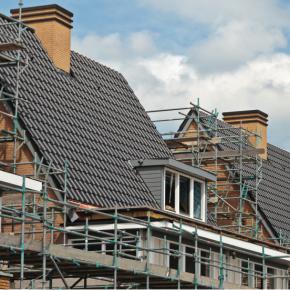
The home quality mark is gathering momentum
Chris Graham, brand manager at Roofing Superstore, a Construction Materials Online company, discusses the impact that the Home Quality Mark had on the roofing and cladding sector and the developments we can expect as the standard gathers momentum, in the latest issue of ABC+D Magazine.
There’s no denying that the UK housing shortage is a problem that continues to escalate, but with an extra £1.4bn earmarked for the construction of 40,000 new homes in 2017, and another £2.3bn pledged for the Housing Infrastructure Fund, significant steps are being taken to address the issue and, in a country famous for its rising energy costs, these new homes will go to buyers increasingly seeking energy-efficient properties.
The introduction of the British Science Centre’s Home Quality Mark (HQM) aims to set a voluntary national standard for all new properties. Filling some of the void left by the (now obsolete) Code for Sustainable Homes, the HQM uses an impartial five-star rating system to indicate a home’s overall quality to prospective purchasers by measuring its performance against a series of financial, well-being, environmental and social factors.
So far, the HQM appears to be a concept welcomed by consumers, with 97% stating that they would be in support of the standard; it could soon be set to become the industry- approved indicator of a comfortable, ecological, energy- efficient and cost-effective home.
Not only that, but it could also act as a key market differentiator for developers in a period of significant sector growth. With global demand for the reduction of carbon emissions ever on the increase, it is also an attractive option for architects and homeowners looking to achieve the maximum in home efficiency.
The criteria for the HQM is strict and a good design only goes some way to meeting it. The materials used across all aspects of a build will play a vital role in determining a property’s final grading.
The standard will serve as an incentive to homebuilders, architects and even specifiers to seek durable and responsibly sourced materials, from quality suppliers and manufacturers, some of which are already leading the way – but with the standard also based on digital connectivity, should construction professionals be embracing more innovative forms of procurement?

“An HQM property must demonstrate excellent thermal properties, ventilation, acoustic qualities and breathability” Chris Graham, Roofing Superstore.
Five-star details
In the year or so since its launch, over 4,000 homes have already been registered for assessment by independent BRE global assessors; proof that the HQM is already gaining traction. But with a rigorous assessment process, developers are required to provide credible and verifiable evidence of how a property meets a series of strict criteria and benchmarks.
Focusing on quality assurance from planning and specification, to final occupation, as well as the promotion of best practice in the housing sector, an HQM property must demonstrate excellent thermal properties, ventilation, acoustic qualities and breathability, as well as ensuring its impact to the surrounding environment is as limited as possible.
BRE provides exacting technical design guidelines outlining the relationship between home design and occupant well-being, assisting designers and developers in making the right choices. For example, the standard advises a daylight factor of at least 2% for kitchens, and a 43Rw (dB) minimum level of sound insulation for internal walls and floors – elements which can have a measurable effect on an occupant’s sense of security, quality of life and community cohesion.
Pioneering products
The mark has already been welcomed by a significant number of manufacturers, who have taken up pilot schemes and begun to promote key elements – from product durability and performance, to those accompanied by industry recognised accreditations, such as an Environment Product Declaration (EPD).
Recognised by the HQM, products with EPD status help to communicate the environmental impact of a building material throughout its lifecycle – evidence of responsible sourcing and future proofing in practice.
Superior insulation is also a vital component of a HQM property, with excellent thermal performance and heat transfer qualities helping to guarantee breathability and airtightness.
Products with BBA certification, or that are Local Authority Building Control endorsed, provide an extra level of quality assurance, with many brands featuring the BBA stamp of approval across their product ranges.
Going digital
As homebuilders and architects select materials with responsible sourcing accreditations and durability guarantees over cheaper alternatives, the construction industry should be poised for a potential change in the way products are currently specified as HQM gathers momentum.
The mark is thorough in its evaluation of what makes a quality home – even digital connectivity is under the microscope, which could provide an opportunity for the construction industry to take a similar approach, utilising more innovative methods of procurement.
Online resources are a valuable channel for architects and contractors when evaluating and purchasing materials in accordance with the HQM.
This is particularly relevant for higher specification or bespoke construction projects, where the more unusual or innovative products required are not stocked readily by over-the-counter merchants. Even when used as a point of reference, construction eCommerce stores can be a convenient resource for those looking for the best HQM-friendly products at a competitive price.
The future of HQM
As a voluntary standard, the future of HQM depends entirely on consumer and homebuilder uptake, but it does go some way in placing both the consumer and environment at the heart of construction, setting a higher standard for the industry.
For those designing new homes, the mark places significant importance at every stage of a build, encouraging greater communication between every element of the supply chain – all of which must work in tandem if the coveted grade is to be achieved.
Materials play a starring role in the HQM, and the industry should use this period of adaptation as an opportunity to adopt new procurement practices to guarantee the high performance and quality associated with the standard, helping to push the boundaries of home design, sustainable building practices and product innovation.
With homeowners set to enjoy a raft of benefits including significantly reduced energy costs, the HQM may become the first choice for all those looking for a new home.
Latest news

17th April 2025
Nuaire shares expertise at Specifi Mechanical Services events in 2025
Indoor air quality and ventilation manufacturing specialist Nuaire is pleased to be exhibiting at the Specifi Mechanical Services events once again in 2025.
Posted in Air Conditioning, Articles, Building Industry Events, Building Industry News, Building Products & Structures, Building Services, Exhibitions and Conferences, Facility Management & Building Services, Heating, Ventilation and Air Conditioning - HVAC, Restoration & Refurbishment, Retrofit & Renovation
15th April 2025
West Fraser: CaberDek earns top marks from Home Counties carpentry specialist
A specialist carpentry sub-contractor covering housing sites across a large swathe of the Home Counties has come to value CaberDek from the West Fraser range for a variety of reasons: not least because the high quality panel product doesn’t destroy his operatives’ electric saws!
Posted in Articles, Building Industry News, Building Products & Structures, Building Systems, Case Studies, Restoration & Refurbishment, Retrofit & Renovation, Roofs, Timber Buildings and Timber Products, Wooden products
15th April 2025
GEZE: The Role of Access Control Systems in Enhancing Building Safety
Jane Elvins, Specification and Business Development Manager at GEZE UK, delves into the role of access control systems in enhancing building safety…
Posted in Access Control & Door Entry Systems, Architectural Ironmongery, Articles, Building Industry News, Building Products & Structures, Building Services, Doors, Facility Management & Building Services, Health & Safety, Restoration & Refurbishment, Retrofit & Renovation, Security and Fire Protection
11th April 2025
Don’t Do a Dave! It’s Time to Lock FIT Show 2025 in Your Calendar!
It’s that time again – FIT Show is back! You could be forgiven for thinking there won’t be much new to see when FIT Show returns to the NEC from 29 April – 1 May. Wrong!
Posted in Articles, Building Industry Events, Building Industry News, Building Products & Structures, Building Services, Continuing Professional Development (CPD's), Exhibitions and Conferences, Information Technology, Innovations & New Products, Restoration & Refurbishment, Retrofit & Renovation, Seminars, Training
 Sign up:
Sign up: